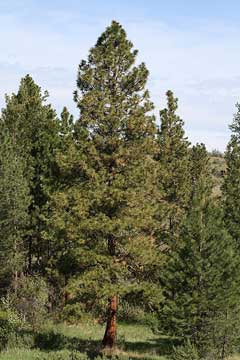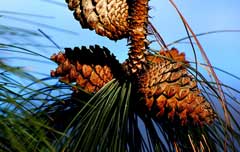 |
|
http://commons.wikimedia.org/wiki/User:Wsiegmund |
 |
| http://www.flickr.com/people/37436953@N08 |
Translate this page:
Summary
Physical Characteristics

 Pinus_ponderosa is an evergreen Tree growing to 25 m (82ft) by 7 m (23ft) at a medium rate.
Pinus_ponderosa is an evergreen Tree growing to 25 m (82ft) by 7 m (23ft) at a medium rate.
See above for USDA hardiness. It is hardy to UK zone 4. It is in leaf all year, in flower in June, and the seeds ripen in October. The species is monoecious (individual flowers are either male or female, but both sexes can be found on the same plant) and is pollinated by Wind. The plant is not self-fertile.
Suitable for: light (sandy) and medium (loamy) soils, prefers well-drained soil and can grow in nutritionally poor soil. Suitable pH: mildly acid and neutral soils. It cannot grow in the shade. It prefers dry or moist soil and can tolerate drought. The plant can tolerates strong winds but not maritime exposure.
UK Hardiness Map
US Hardiness Map
Synonyms
Plant Habitats
Edible Uses
Inner bark - raw or cooked[257]. Mucilaginous[105, 161, 213]. Best harvested in the spring[257]. The inner bark can be eaten fresh, but is more often dried, ground into a powder and either used as a thickener in soups or is mixed with flour for making bread etc[K]. Seed - raw or cooked[63, 64, 105, 226, 257]. Rich in oil, the seed has a slightly resinous flavour. Quite small, it is only about 8mm long[200]. The seed can be crushed into a meal and used in making bread etc[213]. The resin has been chewed as a gum[226, 257]. Young male cones have been chewed for the juice[257]. A vanillin flavouring is obtained as a by-product of other resins that are released from the pulpwood[200].
References More on Edible Uses
Medicinal Uses
Plants For A Future can not take any responsibility for any adverse effects from the use of plants. Always seek advice from a professional before using a plant medicinally.
Ponderosa pine was employed medicinally by several native North American Indian tribes, who valued it especially for its antiseptic and vulnerary properties, using it to treat a range of skin problems, cuts, wounds, burns etc[257]. It was also valued for its beneficial effect upon the respiratory system and was used to treat various chest and lung complaints[257]. The turpentine obtained from the resin of all pine trees is antiseptic, diuretic, rubefacient and vermifuge[4]. It is a valuable remedy used internally in the treatment of kidney and bladder complaints and is used both internally and as a rub and steam bath in the treatment of rheumatic affections[4]. It is also very beneficial to the respiratory system and so is useful in treating diseases of the mucous membranes and respiratory complaints such as coughs, colds, influenza and TB[4]. Externally it is a very beneficial treatment for a variety of skin complaints, wounds, sores, burns, boils etc and is used in the form of liniment plasters, poultices, herbal steam baths and inhalers[4]. The branches are used in herbal steam baths as a treatment for muscular pains[257]. A decoction of the plant tops has been used in the treatment of internal bleeding and high fevers[257]. An infusion of the dried buds has been used as an eye wash[257].
References More on Medicinal Uses
The Bookshop: Edible Plant Books
Our Latest books on Perennial Plants For Food Forests and Permaculture Gardens in paperback or digital formats.

Edible Tropical Plants
Food Forest Plants for Hotter Conditions: 250+ Plants For Tropical Food Forests & Permaculture Gardens.
More

Edible Temperate Plants
Plants for Your Food Forest: 500 Plants for Temperate Food Forests & Permaculture Gardens.
More

More Books
PFAF have eight books available in paperback and digital formats. Browse the shop for more information.
Shop Now
Other Uses
A tan or green dye is obtained from the needles[168]. A yellow dye can be made from the pollen[226]. A blue dye can be made from the roots[257]. The needles contain a substance called terpene, this is released when rain washes over the needles and it has a negative effect on the germination of some plants, including wheat[201]. The branches are used as a strewing herb[99]. A decoction of the plant tops has been used as a conditioning wash to give a person a fair and smooth skin[257]. A fairly wind-tolerant tree, it can be used in shelterbelt plantings[200]. This tree is a source of resin, though it is not exploited commercially[64, 171]. Oleo-resins are present in the tissues of all species of pines, but these are often not present in sufficient quantity to make their extraction economically worthwhile[64]. The resins are obtained by tapping the trunk, or by destructive distillation of the wood[4, 64]. In general, trees from warmer areas of distribution give the higher yields[64]. Turpentine consists of an average of 20% of the oleo-resin[64] and is separated by distillation[4, 64]. Turpentine has a wide range of uses including as a solvent for waxes etc, for making varnish, medicinal etc[4]. Rosin is the substance left after turpentine is removed. This is used by violinists on their bows and also in making sealing wax, varnish etc[4]. Pitch can also be obtained from the resin and is used for waterproofing, as a wood preservative, adhesive etc[257]. It burns well and so has been used to make torches[257]. The root fibres have been used in making baskets[257]. Material for insulation and a tinder are also obtained from the tree[99]. The cones make a quick fire, whilst the scales from the trunk bark burn easily, give off no smoke and cool quickly[213]. Wood - light, strong, fine-grained and pleasantly aromatic, the wood can vary from soft to hard[1, 46, 82, 171, 226, 229]. An important lumber tree, it is used for making furniture, boxes, toys etc[1, 46, 82, 171, 226, 229], and it is also used for fuel[99]. For reasons that are unclear, some tree stumps contain high concentrations of pitch - this makes them very rot-resistant and inflammable and therefore useful for fence posts and kindling[226].
Special Uses
References More on Other Uses
Cultivation details
Thrives in a light well-drained sandy or gravelly loam[1, 11]. Dislikes poorly drained moorland soils[1]. Established plants tolerate drought[200]. Seedlings strongly dislike growing in the shade[60] and are unable to succeed under the canopy of the parent trees[226]. Plants are fairly wind tolerant[200]. Extensively used in cool temperate forestry[200], this species is occasionally planted for timber in central and southern Europe[50]. Growth can be quite fast when young but it soon drops of and averages around 30cm per year[185]. The best trees in Britain are found in a belt running from Kent through the Midlands to N. Wales and also in S. Scotland[185]. Trees live 300 - 600 years in the wild[229], they seem to be long-lived and healthy in Britain[185]. Seed production commences when the tree is about 20 years old[229]. There are usually several years of low to medium yields between each year of high yields[229]. The cones are 8 - 15cm long, they open and shed their seed whilst still attached to the tree and then soon fall from the tree[82, 226]. Plants are strongly outbreeding, self-fertilized seed usually grows poorly[200]. They hybridize freely with other members of this genus[200]. Leaf secretions inhibit the germination of seeds, thereby reducing the amount of plants that can grow under the trees[18]. Plants in this genus are notably susceptible to honey fungus[200].
References Carbon Farming Information and Carbon Sequestration Information
Temperature Converter
Type a value in the Celsius field to convert the value to Fahrenheit:
Fahrenheit:
The PFAF Bookshop
Plants For A Future have a number of books available in paperback and digital form. Book titles include Edible Plants, Edible Perennials, Edible Trees,Edible Shrubs, Woodland Gardening, and Temperate Food Forest Plants. Our new book is Food Forest Plants For Hotter Conditions (Tropical and Sub-Tropical).
Shop Now
Plant Propagation
It is best to sow the seed in individual pots in a cold frame as soon as it is ripe if this is possible otherwise in late winter. A short stratification of 6 weeks at 4°c can improve the germination of stored seed[80]. Plant seedlings out into their permanent positions as soon as possible and protect them for their first winter or two[11]. Plants have a very sparse root system and the sooner they are planted into their permanent positions the better they will grow[K]. Trees should be planted into their permanent positions when they are quite small, between 30 and 90cm[200]. We actually plant them out when they are about 5 - 10cm tall. So long as they are given a very good weed-excluding mulch they establish very well[K]. Larger trees will check badly and hardly put on any growth for several years. This also badly affects root development and wind resistance[200]. Cuttings. This method only works when taken from very young trees less than 10 years old. Use single leaf fascicles with the base of the short shoot. Disbudding the shoots some weeks before taking the cuttings can help. Cuttings are normally slow to grow away[81].
Other Names
If available other names are mentioned here
Native Range
NORTHERN AMERICA: Canada (British Columbia (south)), United States (Nebraska, North Dakota (west), Oklahoma, South Dakota, Idaho, Montana, Oregon, Washington, Wyoming, New Mexico, Texas, Arizona, California, Nevada, Utah), Mexico (Chihuahua, Coahuila de Zaragoza, Durango, Sonora, Zacatecas)
Weed Potential
Right plant wrong place. We are currently updating this section.
Please note that a plant may be invasive in one area but may not in your area so it’s worth checking.
Conservation Status
IUCN Red List of Threatened Plants Status :

Growth: S = slow M = medium F = fast. Soil: L = light (sandy) M = medium H = heavy (clay). pH: A = acid N = neutral B = basic (alkaline). Shade: F = full shade S = semi-shade N = no shade. Moisture: D = dry M = Moist We = wet Wa = water.
Expert comment
Author
Douglas. ex Lawson.&C.Lawson.
Botanical References
1160200
Links / References
For a list of references used on this page please go here
Readers comment